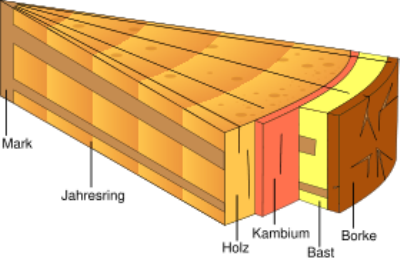Anatomical structure of wood
To gain a better understanding of the structure of wood, it’s first of all necessary to take a look inside the tree to see its different cells and other components and their various functions.
A cross-section of a tree trunk from the centre to the outside shows the following zones: right at the centre is the pith, made of ground tissue and the dead heartwood. In this section, which is no longer needed for the sustenance of the tree, many different species store various substances that can lead to increased durability compared with the sapwood, which isn’t durable at all. These retained substances sometimes lead to the discolouration of the heartwood, enabling it to be clearly distinguished from the sapwood. In the strictest sense, heartwood and sapwood make up the actual wood. On top of this comes the growth layer, Cambium, which constantly builds up new wood. The outer layer consists of the bast, which transports nutrients dissolved in water, and the bark which protects the trunk from the effects of the environment. Depending on the species, the wood is made of different, mostly spindle or tubular-shaped cells. They in turn consist of a cavity – the vacuole – and the cell walls.
Wood has a structure specific to each species, enabling them to be distinguished from each other by their macro and micro structures.
From an evolutionary point of view, conifers are much older than deciduous trees, so their anatomical cell structure is simpler and they only have two kinds of cells. Tracheids: long cells which taper to a point at the ends and are only filled with water or air. They combine water conducting and hardening functions and make up around 90–100 % of the wood’s substance. Fluid exchange from cell to cell occurs via openings working like non-return valves, the so-called pits. In the rays, they operate as transverse tracheids transporting water and mineral nutrients in a radial direction. They make up 4–12 % of the total wood substance. Parenchyma cells: looked at in longitudinal section, these are mostly rectangular cells that a responsible for conducting nutrients and storing starch and fats. In a radial direction, as ray parenchyma, they make up majority of the ray tissue. The parenchyma cells that surround the resin ducts work as an epithelium and produce the resin which they discharge into the resin duct.
Deciduous wood has various cell types. For conducting sap, there are up tubular vessels (tracheae) which are up to one metre long. The wood’s strength comes from long, thick-walled fibre cells (sclerenchyma cells) which are only 0.5 – 1.5 mm long. Just like in conifers, all deciduous trees in spring mostly produce sap-conducting, thin-walled vessels, though some trees only produce such vessels. In summer and autumn, more thick-walled support cells tend to grow. The marked difference between thick-walled summerwood cells and large-pore springwood cells makes each year’s growth clearly visible in the form of annular rings. In deciduous trees, the abundance and size of the springwood cells is good method of distinguishing between wood species. Trees which in the spring form distinctly large-pore vessels that are clearly visible as a ring of pores in the trunk, are known as ring-porous, such as oak, ash and elm. Other deciduous species with less distinct vessels are known as diffuse porous, like maple and beech.
